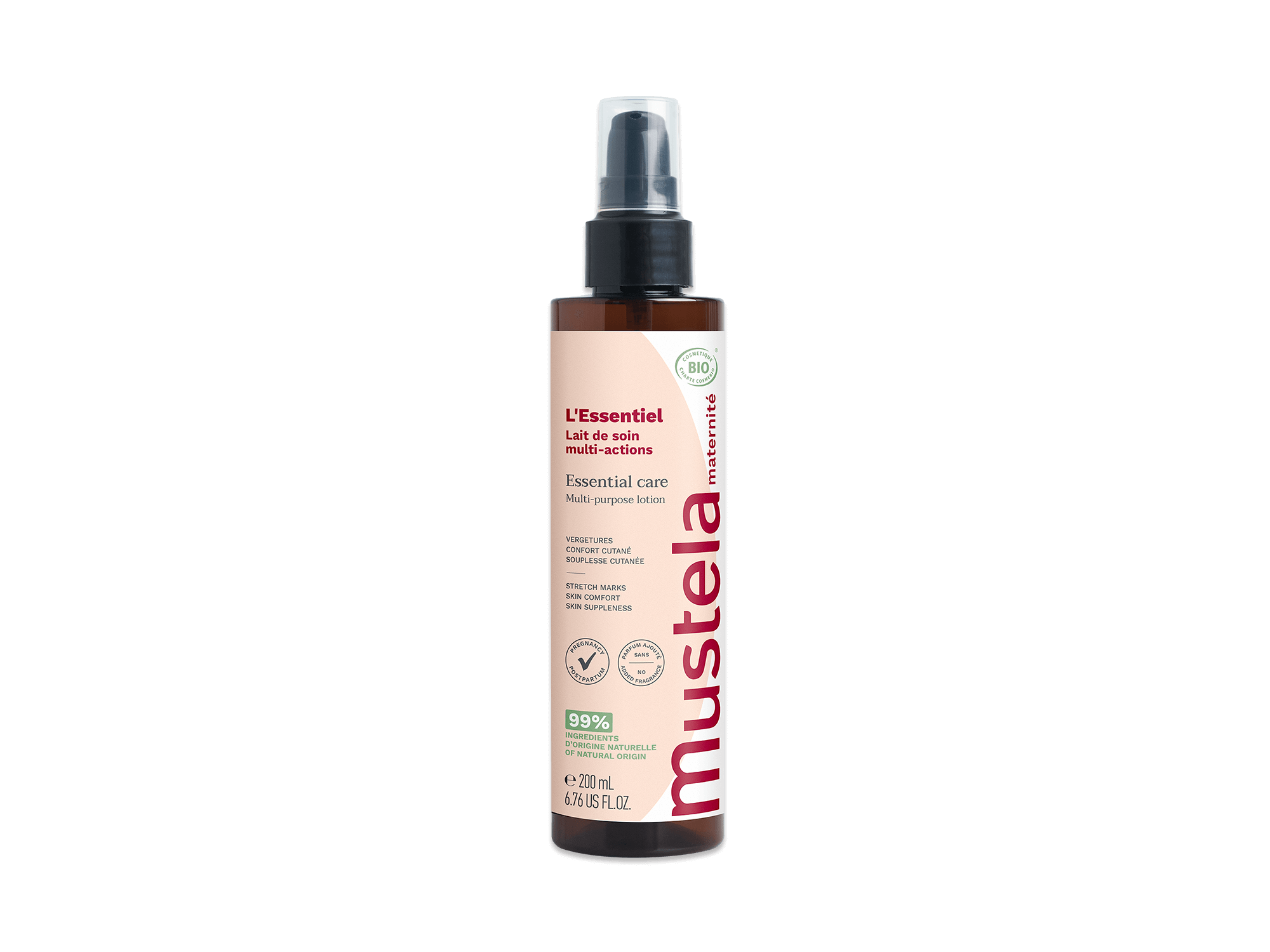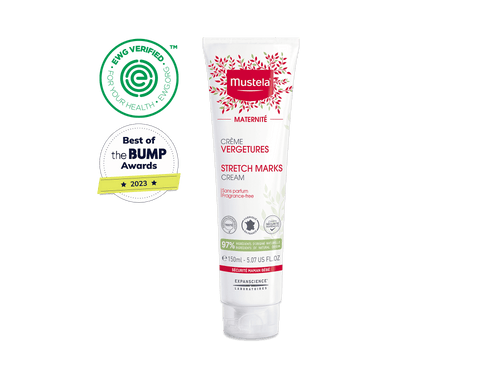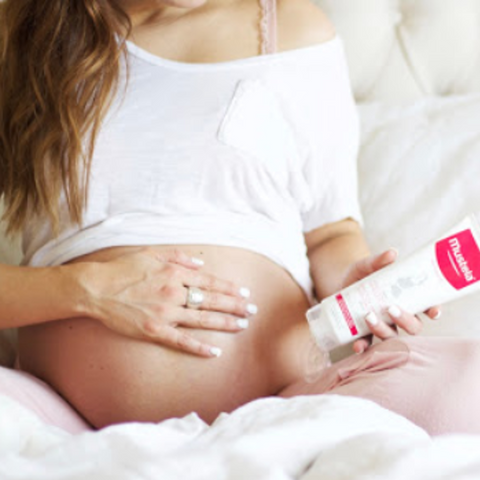All good things must come to an end, breastfeeding included. If you’re wondering just exactly how to stop breastfeeding, Mustela has you covered!
In this article, our experts discuss different methods of weaning your baby so you can discover which one is right for you. And while you’re at it, check out our tips for a happy mom and baby during this time of transition!
When To Stop Breastfeeding

There’s no right time to stop breastfeeding your baby. It’s totally up to you and what you feel comfortable with. Some cultures even nurse their little ones through the toddler years!
To get a good idea of when to stop breastfeeding, follow The American Academy of Pediatrics (AAP) guidelines. They recommend exclusively breastfeeding for at least the first six months of your baby’s life and continuing until their second birthday or beyond.
(We understand this is not always possible. But if you can make it happen, go for it!
Once your baby is introduced to solids around the six-month mark, the volume of your breast milk changes. Your baby will nurse less because they’ll be getting full on food instead of your milk, and your body will adjust.
At this point, your baby’s little belly is growing and so are their nutritional needs. The time will soon come to cut out breastfeeding altogether. But how?
There are a few different ways to approach this transition, so now that we’ve talked about the when, let’s take a look at how to stop breastfeeding.
How To Stop Breastfeeding Gradually

The safest way to stop breastfeeding is to gradually wean yourself and your baby. Gradual weaning reduces your chances of getting blocked ducts or mastitis, which are very painful for you!
Gradually weaning is gentle on your baby and allows your body and hormones to slowly adjust. And that’s just what this will be: an adjustment for both you and your baby!
There are a few ways to stop breastfeeding gradually. The first one is by dropping one feeding every three days; the second one is by shaving off a few minutes of each feeding; and the third one is by practicing baby-led weaning.
Let’s take a look at each method in detail so you can make the best decision for your family, particularly for you and your baby.
Drop One Feeding Every Three Days
By the time your baby is one year old, you’re probably only nursing around three times a day: morning, afternoon, and evening.
For the first method of gradual weaning, start by dropping the afternoon feeding. Wait a few days and then drop the morning feeding.
This means that your baby will only nurse once a day — at night. But your little one may need more than just a few days in-between each phase to adapt. Always be aware of your baby’s needs and adjust accordingly.
Leave the late evening feeding as the last one you drop. This feeding may take a few more days for you and your baby to adjust to.
Remember every baby is different. So if your baby needs more than three days to drop a feeding, that’s OK. Soak up these last precious moments of nursing your little one!
Shave A Few Minutes Off Of Each Feeding

The main goal of shaving minutes off of each feeding is to reduce your baby’s demand, which reduces your milk supply. This will make the transition easier on your breasts as well as your baby!
To achieve this, gradually cut a few minutes off of your baby’s usual feeding time to make the sessions less satisfying, especially if your baby likes to nurse for comfort.
For example, if your little one nurses for 15 minutes, pull away around the 12-minute mark. Do this for every feeding for one to two days. Continue shaving off time of each feeding until your baby no longer shows interest or your milk dries up.
The goal of these two weaning methods is to get your breastmilk to naturally dry up. The time it takes for this to happen varies.
During this time while you gradually stop nursing, you may need to hand-express your milk. But only express enough to ease any discomfort because you don’t want to encourage your body to produce more milk.
Practice Baby-Led Weaning
Pay attention to your baby and their needs. Some babies naturally wean from the breast on their own. If your baby is no longer interested in nursing or pulls away when you offer your breast, then it’s a good sign they’re starting to self-wean.
With this particular method, your baby can adjust easily because weaning is now on their terms — whenever they feel comfortable. Your body will follow their lead.
Your milk supply will naturally dry up due to the decrease in your baby’s need for your milk, making it an easier adjustment for your body as well.
How To Stop Breastfeeding Right Away

Sometimes circumstances are out of your control and for unexpected reasons, you may have to abruptly stop breastfeeding. There’s no particular weaning method when you need to immediately stop breastfeeding. You simply no longer offer your breasts to your baby when it’s time for them to eat.
This is not ideal, but sometimes you have no other choice. Possible reasons for stopping breastfeeding right away include:
- A change in your work schedule
- Taking a certain medication that might not be safe for your baby
- Your physical and mental health aren’t allowing you to continue breastfeeding
- Sore or painful breasts or nipples (When this happens, use our Nursing Comfort Balm to protect your nipples, ease discomfort, and replenish your skin during and after breastfeeding!)
- Low milk supply
- Your baby is diagnosed with failure to thrive and needs a change of nutrition
- Getting pregnant again (With guidance from your doctor, you can still breastfeed your baby while pregnant. However, you may feel tired, and changes in your appetite and emotions can make breastfeeding challenging while you’re pregnant.)
With this method, you’re at risk for a breast infection, mastitis, and for a painful experience.
To ease the discomfort of stopping breastfeeding cold turkey — and to ensure a happy transition no matter which method you choose — follow our tips below. But first, let’s look at the symptoms of mastitis so you know what to watch for.
Symptoms Of Mastitis
Breastfeeding (and stopping breastfeeding) makes you more prone to developing an infection called mastitis. It can occur in one or both breasts.
Whenever you make changes to your breastfeeding routine, pay attention to these symptoms:
- Swollen and tender breasts
- Painful, burning sensation
- Redness and warmth on the breast surface
- A lump or hard spot in your breast
- Fever, chills, and body aches
- A general feeling of being unwell
If you notice anything concerning about your breasts, talk to your doctor immediately. When mastitis is left untreated, it can cause an abscess that will need to be drained surgically.
Mastitis Treatment
Your doctor may prescribe a course of antibiotics to clear up the infection. They may also recommend over-the-counter pain relievers to provide relief.
Here are a few other things you can do to ease the discomfort of mastitis.
- Apply a warm compress
- Take a warm shower
- Get plenty of rest
- Stay hydrated
- Wear loose, comfortable clothing that won’t irritate your breasts
Tips For A Happy Mom And Baby While Weaning

The following tips can help minimize discomfort and keep your baby happy during the weaning process.
Have A Plan
Once you’re done breastfeeding, your baby will need something else for nourishment. Here are some options based on their age:
-
Formula: If your baby isn’t yet one, they’ll need formula as their primary source of nutrition. You can find more information on infant feeding schedules for formula here. You can also introduce solid foods if they’re over six months old.
-
Frozen Breast Milk: If you’ve been able to pump extra milk and freeze it, you can defrost it and feed it to your little one. When frozen, breast milk lasts between 9 and 12 months (depending on the type of freezer).
-
Cow’s Milk: After age one, most babies transition to cow’s milk. They should have whole milk until they turn two, as their developing brain needs the fat for proper growth.
- Alternative Milk: Some parents introduce plant-based milk, like almond or oat milk, after their child’s first birthday. Speak to your pediatrician for specific recommendations.
No matter what food choice comes next, you’ll want to gather everything you need before you start the weaning process. That way, you don’t have to try to figure it out when your baby is hungry and frustrated.
Remember That Fed Is Best
Depending on when or why you’re stopping breastfeeding, you might get a range of reactions from well-meaning friends and family. Some may encourage you to keep going, while others might congratulate you for making it as long as you did.
Remember that every mother-baby pair is unique, and there’s not one “right” way to feed your baby. The important thing is that your baby is fed and thriving. Trust your instincts as a mother and do what is right for you and your little one.
Wear A Supportive Bra
Having good support for your breasts can make a huge difference in how this transition goes. Your breasts may still feel full for a few days after your baby stops nursing, and wearing the right bra can help relieve pain and discomfort while your body adjusts.
Choose Soothing And Restorative Skin Care Products

Choosing the right skin care products can be a game-changer while you’re learning how to stop
breastfeeding! As we mentioned above, our Nursing Comfort Balm is one of those products!
Our Certified Organic Essential Care Multi-Purpose Lotion is another. The maracuja fruit in it helps soothe discomfort and promote skin suppleness.
Reduce Pain And Swelling With Ice Packs Or Cabbage Leaves
If you’re experiencing pain or swelling, ice packs or frozen cabbage leaves can help! The cold will ease your pain and may also help your breast milk dry up.
To prepare the cabbage leaves, cut several off of a large head of cabbage. If the leaf has hard veins, remove them.
Carefully wash each leaf and let it dry. Then, chill for several hours. You can leave them in the refrigerator or freeze them to speed up the process. Once cold, the leaves are ready to use.
Simply put an ice pack or cabbage leaves inside your bra to easily relieve pain and reduce swelling. Leave them on your breast for 15-20 minutes.
It should take anywhere between seven to ten days after you completely stop breastfeeding for your breastmilk to dry up.
Hand-Express Your Milk
Using a pump while you’re trying to stop breastfeeding may actually boost your milk supply. This is not what you’re aiming for!
To relieve any discomfort, steer clear of the breast pump and hand-express your milk instead. These tips can help make the hand-expression more effective:
- Only express if your breasts are really full and you’re uncomfortable
- Wash your hands before you begin
- Gently place your thumb above your nipple and your fingers below it
- Keeping your hands cupped in a “C” shape, gently push back and slide forward
- Repeat as needed to remove a small amount of milk
- Do not completely empty your breasts; stop expressing when you feel comfortable again
- Avoid using a lot of pressure
Wear Nursing Pads
In the early days of weaning, you may experience leakage. Nursing pads can help absorb any milk that leaks out and prevent embarrassing wet spots on your clothing. You won’t have to wear these for long, but they can be helpful during this transitional period.
Look for reusable cotton pads or disposable ones made with natural materials to avoid potential irritation.
Stay Healthy

Your body will go through some changes during this time, so it’s important to stay healthy. To keep your body in the best shape possible while weaning your baby, eat a well-balanced diet and exercise.
Eating well and exercising were crucial while you were breastfeeding, and they’re still important while you’re trying to stop breastfeeding. These long-term habits are good to practice no matter what stage of life you’re in!
Continue To Bond With Your Baby
As you know by now, there’s more to breastfeeding than providing nutrition and calories to your baby. Your little one (and you!) will miss the closeness that comes with these feeding sessions once you stop nursing.
So keep stealing those special moments and snuggling up close with your baby whenever you can!
Prepare For Fussiness
As your baby adjusts to no longer breastfeeding, you may notice temporary changes in their behavior. They may become more fussy or clingy as they adapt to the new eating habits. Depending on their age, they may also try pulling on your shirt and trying to access your breasts.
Don’t worry — this is normal and will pass as your little one gets used to the new routine. Redirection can help. Offer them other comforting activities or objects, such as a favorite toy or a walk outside, to help distract and soothe them during this transition period.
You may also need to tell your baby, “No.” Some moms use creative wording, such as, “Mommy’s milk is all gone” or “No milky now.” However you word it, consistently say it each time they try to nurse. They’ll soon learn that breastfeeding is no longer an option.
Change Your Wardrobe
If your little one can easily access your breasts, they may try a sneak attack when you least expect it. This is much easier for them if you’re wearing nursing-friendly clothes.
To make it more challenging, put on an extra layer, or choose clothes that don’t have nursing slits. This visual reminder can also help you resist the temptation to give in if your little one starts fussing.
Let Your Baby Spend Time With Others

Let’s face it — you smell like milk, and whenever your baby sees you, they probably think about milk! You and breastfeeding are so closely intertwined that it may take some time for them to adjust to the idea of you not being their primary source of food.
During this phase, they may refuse to take a bottle or bite of solid food from you. Instead, they may cry and try to get you to give in and nurse.
That’s where other caregivers come in. If possible, encourage your partner or other trusted friends or family members to spend time with your little one throughout the weaning process. The different faces and a change of scenery can help distract them from their usual routine.
And it’ll give you a chance to take a much-needed break!
Enjoy A Snack Together
Breastfeeding provides a special bond over food between you and your baby. But just because you stop nursing doesn’t mean you have to lose that connection. Enjoying a snack together (at a time when you previously breastfed) can be a good alternative.
It allows for quality time together while still providing nourishment. This can be especially helpful in the early stages of weaning, when your baby may still crave closeness and comfort.
Be Kind To Yourself
Weaning can be an emotional and physical journey for you and your baby. It’s important to be gentle with yourself and acknowledge any feelings that may arise.
If you’re feeling sad or guilty about weaning, know these are normal reactions, and it’s OK to feel them. Remember that you have provided your baby with a strong foundation by breastfeeding as long as you did and that you’re going to continue to nurture them in other ways.
Journaling can help you process the emotions that come when you stop breastfeeding. Writing down your thoughts can be cathartic and help you work through big feelings.
You can also talk to a trusted friend, family member, or therapist. They can help you navigate these emotions and offer support during this challenge.
Embrace The Next Chapter
Weaning marks the end of one chapter in your parenting journey and the beginning of another. As your child grows and becomes more independent, you’ll face new challenges and milestones together.
Embrace this next chapter with open arms and remember that each phase is special in its own way. As you reflect on your breastfeeding history, be proud of yourself for the fantastic job you have done. You’ve given your baby the gift of nourishment, comfort, and love.
No matter how long or short your journey may have been, it has been a meaningful experience for you and your little one.
Breastfeeding And Beyond

With the right skin care and our tips for how to stop breastfeeding, both you and your baby can be happy and healthy throughout the weaning process.
Whether you’re gradually reducing your breastfeeding sessions, stopping immediately, or letting your baby lead the way, Mustela is here for you.
This parenting journey is so much better when we do it together! That’s why we created postpartum products to meet your needs through this transition, like our Certified Organic Essential Care Multi-Purpose Lotion and Nursing Comfort Balm. Your breasts will thank you!



















